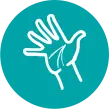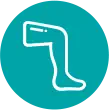

Orthopaedics is the branch of medicine that deals with the diagnosis and treatment of the musculoskeletal system (joints, bones, ligaments, tendons, cartilage, and muscles). An Orthopaedic specialist, also known as an orthopaedic surgeon, plays a vital role in diagnosing, treating, and performing surgeries related to musculoskeletal disorders and injuries.
Orthopaedic specialists, often referred to as bone specialists, treat common conditions, including osteoarthritis, neck, back, and shoulder pain, bone fractures, soft tissue (ligament, tendon, muscle) injuries such as sprains and strains, and congenital conditions (scoliosis and clubfoot).
Select a body part or click the "+" symbol on the human skeleton diagram to learn more about orthopaedic conditions and symptoms.

Elbow

Hands & Wrist

Knee

Spine
The team of professional Orthopaedic specialists at Gleneagles Hospitals can assess, diagnose, and recommend appropriate treatment options such as knee/hip replacement, knee arthroscopy, carpal tunnel release, and more.
Whether you require treatment for sports injuries, joint disorders, or complex orthopaedic surgeries, the experts at Gleneagles Hospitals deliver personalised solutions to ensure the best outcomes. Trust the top orthopaedists in Malaysia to help restore mobility and improve quality of life. Schedule a consultation today and take the first step toward recovery.


Wait a minute